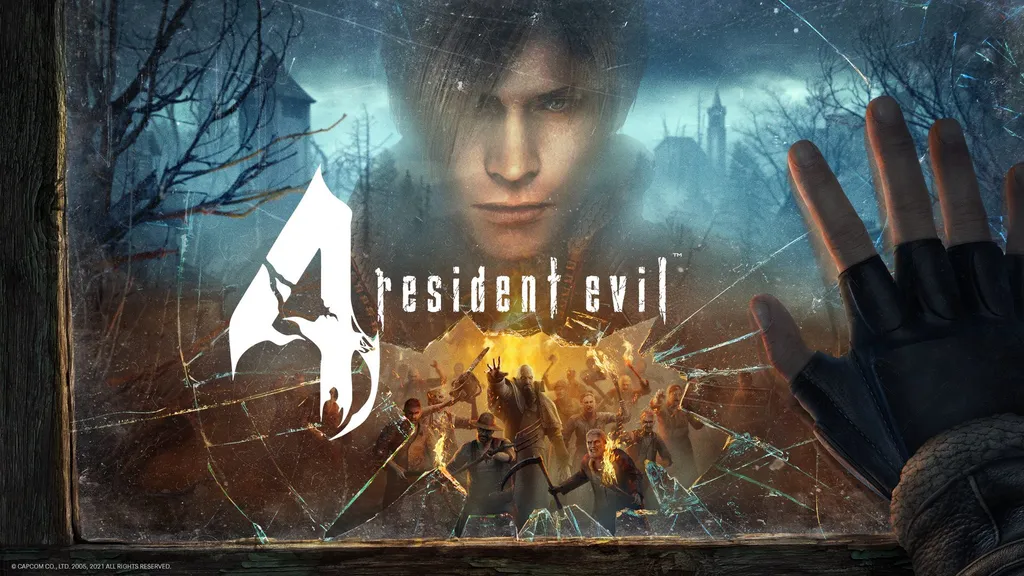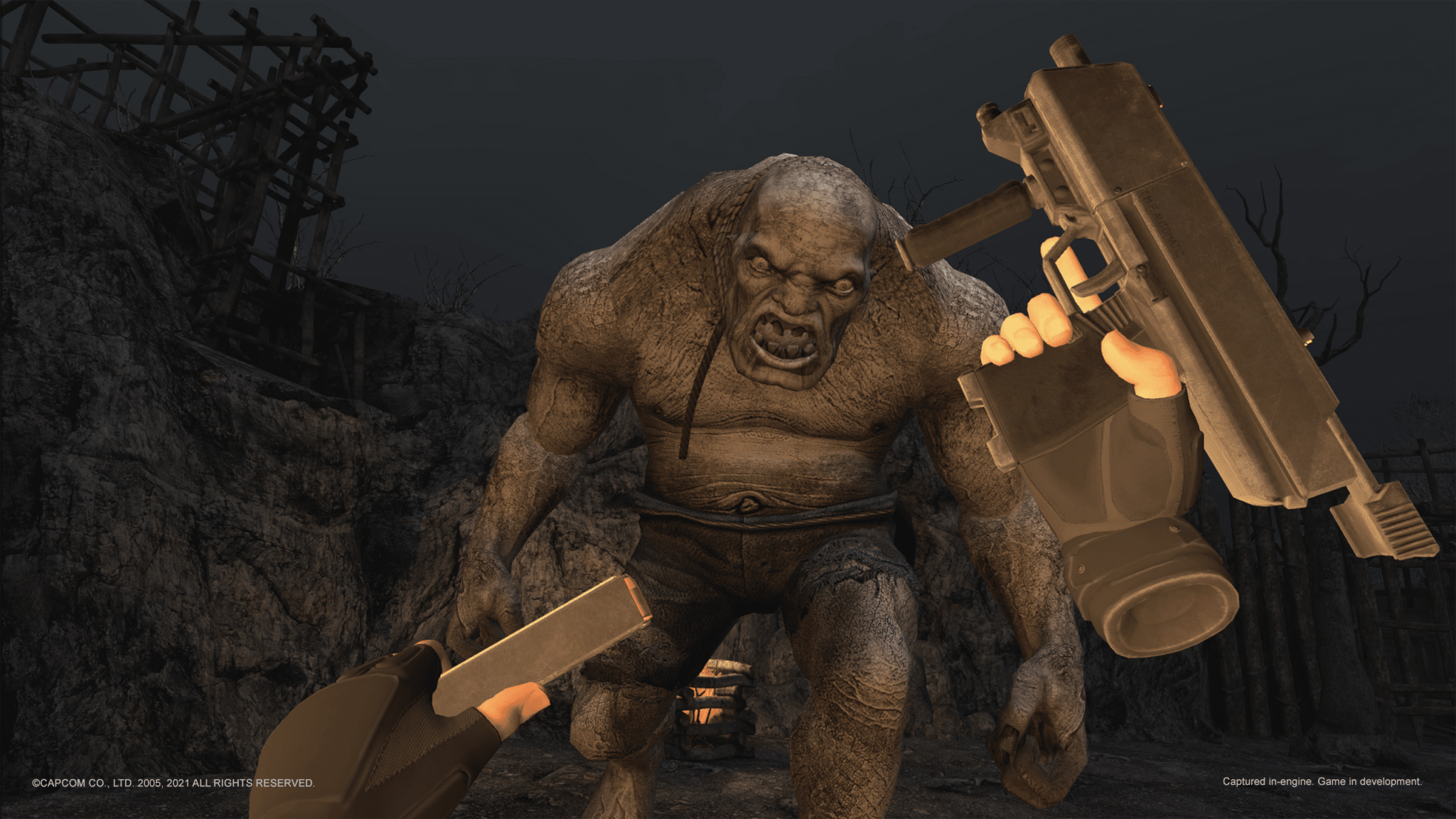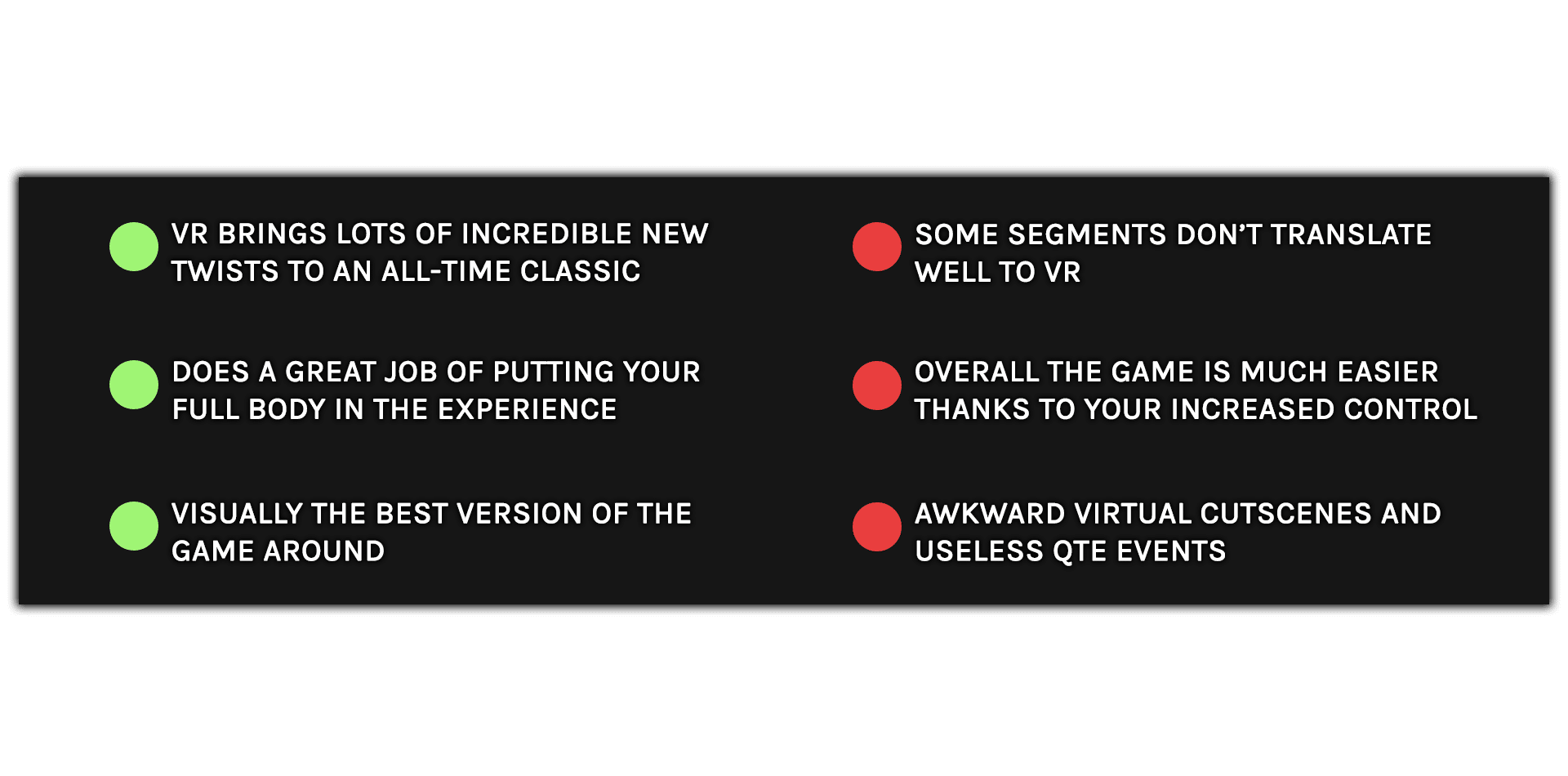There are clear issues with the port and you should play the original first, but Resident Evil 4 is still a powerful experience in VR. Read on for our Resident Evil 4 VR review.
Like you, I’m sure, I was worried. Very worried, in fact. Fans are rightfully protective over Resident Evil 4 and its pristine plotting and pacing. It was difficult to imagine a VR port that didn’t muddy the game’s immaculately precise brand of action which, for many, would be nothing short of heresy.
And Resident Evil 4 VR is muddy. It can be messy and archaic, never more than a few steps away from an awkward screen transition or useless quick-time event (QTE). But it can just as often work surprisingly well, with moments of refreshed intensity and heightened horror. It’s not often you get the chance to experience something so cherished with fresh eyes. Resident Evil 4 VR doesn’t squander that opportunity.
Developer Armature has paid meticulous attention to almost every angle of the original, bringing the entire campaign over to Quest 2. Resident Evil 4 itself was something of an overhaul for the series, ditching the static-cameras and (at least partially) the tank controls of the original games, but it’s almost unrecognizable here. Gone is the defining over-the-shoulder camera, replaced with a first-person view. No longer does Leon sluggishly drag the aim cursor across the screen with all the urgency of a tortoise, enemies are instead at the mercy of your own marksmanship. No more canned reload animations and no long ladder climbing but, in-trade, you can walk and aim, there’s dual-wielding weapons, full freedom of movement and much more. The content of the game might be the same, but actually playing it is a fundamentally different experience.
What is it?: A full VR port of the 2005 horror classic in which Leon Kennedy battles infected humans to save the President’s daughter.
Platforms: Oculus Quest
Release Date: October 21
Price: $39.99
This, as you can probably imagine, causes friction in some areas, and opportunities in others. But the game gives and takes in pretty much equal measure. The original Resident Evil 4 was a game of astonishingly deliberate flow; Leon couldn’t side-step, making it incredibly difficult to get out of harm’s way, switching out guns meant diving back into the inventory every few seconds, and scoring vital headshots to save on limited ammo was a really tricky affair. Any time you raised a weapon up to fight, Leon would stop dead in his tracks and you could no longer walk. It sounds a little rusty and, in truth, it is, but it’s also impeccably calculated, with no single encounter over the game’s 10 – 15 hour campaign (depending on your familiarity with it) feeling phoned in.
Now, for what it’s worth, you can play Resident Evil 4 VR with these classic controls replicated as best as possible in the settings menu and I’m sure purists will get a kick out of revisiting the game in this way. But, as strange as it is to return to the game with this newfound mobility, it’s stranger still to play a VR experience in which you can’t walk directly left or right, and the full freedom mode very much feels like the way the game is meant to be played.
So, yes, Resident Evil 4 feels fundamentally easier than it ever has. Side-stepping a Ganados as they lurch towards you becomes second nature, as does sprinting up to an enemy, pointing a rifle right in their face and then pulling the trigger before backpedaling to safety. This can be a problem. Having beaten the original game more times than I care to count, I defeated the iconic first El Gigante encounter in record time and, practically none of the game’s bosses can keep up with your increased speed. As with other versions, the hardest difficulty mode is locked when you first boot up the game and hardcore fans would probably have a better time playing on this mode first, so it’s a shame it’s not available right away.
It’s easier still if you stick with the classic laser sight that lets you pull off headshots from the hip. That said, if you’re like me, you’ll get much more satisfaction out of turning that feature off and aiming down the sights. It does a much better job of helping you step into the role and, ultimately, that’s the point.
Resident Evil 4 VR might be more forgiving but that’s mainly because it does such a fantastic job of putting your whole body into the experience. In the original game, you’d need to step back from a hatch to find an angle to throw a grenade down the hole from afar. Here you can simply pull the pin, drop the grenade and delight at the fiery inferno you’ve caused below. The same goes for quickly switching between two weapons fitted to your holster to provide last-minute relief when your back’s against the wall, or using one arm to aim while another turns a handle – there are plenty of new twists that give the game’s tightly designed sequences some fresh perspective.
That freedom is at the core of Resident Evil 4 VR, and it’s also exactly why you should play the original game as intended before experiencing it on Oculus Quest. There is at least some of what made the original game tick in here, but, when all’s said and done, it’s a fundamentally different beast. Not better, not necessarily worse, just different. And I think you need to understand what the game was at first to really appreciate how it holds up in VR.
Whether you take that advice or not, there’s still plenty to enjoy here. To this day there’s nothing quite like throwing yourself into a crowd of shuffling Ganandos, frantically firing off shots left and right, tossing out a flash grenade to get yourself just a few seconds to sprint across the room, hunker down in another corner, fumble a reload and prepare for round 2. There’s an unmatched flow that proves exhilarating time and again and, even with the VR version’s faster pacing, it rarely buckles under the weight of these changes.
Though free movement feels like the ‘right’ way to play Resident Evil 4 VR, you can also turn on teleport locomotion or use tunneling when moving, too. Still, this is an intense game with fast action and likely needs some acclimatization; there are moments on moving vehicles that might make you sick and the ending sequence in particular is one of the more intense moments I’ve experienced in VR. Keep that in mind before heading into the horror.
And some moments are tougher, too. The cramped confines of the early cabin shootout, in which Leon and companion Luis must hold off hordes of home invaders, is even more claustrophobic than before, with limited room to move even your arms amongst the sea of ghoulish bodies. You’ll also be either delighted or horrified to know that its scariest moments are much more frightening (I’m looking at you, maze with angry zombie dogs), though the game overall remains a very manageable level of terror.
Armature has certainly performed a small miracle getting some sense of cohesion out of this port, then. But even the might of Facebook funding can’t fully escape some of Resident Evil 4’s original 2D design. It gets incredibly bothersome to have the action constantly interrupted by the original’s cutscenes, which are displayed on a 2D screen and often break the illusion if not outright disorienting you. There’s nothing more confusing than running to the top of a ladder, watching Leon push it over on a virtual screen, and then finding yourself staring in a different direction to where you were before.
Mercifully, you can turn off most of the game’s QTEs, but some are unavoidable, which means a lot of waving your arms around to pull Leon up over ledges or backflip over lasers, and you can’t help but wonder if we’d have been better off with an abridged version that skipped these sections.
For example, there’s one moment in which Leon rides a minecart. It’s a thrilling setpiece, with a visceral sense of speed in VR. But, towards the end, the cart goes on a rapid downward spiral before vaulting over a gap and making you swing your arms to clear the chasm. You watch all of this final section on the screen. It’s a huge anticlimax that stings all the more when you see the lengths Armature’s gone to to redesign some of the game’s puzzles to fit the platform, too.
Other smaller issues make themselves known throughout. You can’t duck under trip mines despite throwing yourself to the floor, for example, and I encountered just a few glitches I’ve never seen in the original game, like sending one late-game boss running in circles as I leaned over a ladder. Enemies can shoot through what you might’ve mistaken for cover, and it’s tougher to take care of Ashley in the game’s escort missions when you often can’t see where she actually is.
Perhaps my biggest gripe beyond the cutscenes is the lack of decent spatial audio, which constantly makes you feel like an enemy is breathing down your neck when they’re in fact behind a wall a good few meters away from you. You’ll also be disappointed to learn that the game doesn’t have the bonus Mercenaries mode or additional campaigns that featured in past versions, which is a shame given all of the assets and environments they use are already up and running inside the Quest 2, though you can at least revisit the target practice minigame.
But if there is one area where the game is at least definitively better than the original versions, it’s in the visuals department. Capcom’s HD ‘remasters’ of RE4 were always underwhelming, but Armature has given the game the scrub-up it deserves with up-rezzed textures that hold up to a kind of scrutiny you could never really give them on a flat-screen. It’s especially impressive to revisit some of the original game’s most iconic sights from a new angle and, even though it’s approaching its 20th anniversary, it overall looks stunning in VR. There are some 2D textures that should really be in 3D and Ashely looks weirdly tall and incredibly small at the same time, but that’s about it.
Resident Evil 4 VR Review – Final Impressions
Resident Evil 4 VR is an incredible, if not definitive take on an all-time classic. There are a lot of rough edges to this port like the constant cutting to virtual screens, lack of spatial audio and certain combat encounters that simply don’t translate well to VR. But, for every moment of Wii-waggle boulder dodging or tarnished memories of once much more demanding boss fights, developer Armature mines gold elsewhere. Whether it’s the brilliantly redesigned puzzles, the slick satisfaction of pulling off headshots with careful aim or simply taking in this world of terror from a fresh new angle, there are a lot of reasons to relive the horror. I suspect it’s best enjoyed as a novel way to revisit one of the all-time greats than it is to approach fresh but whatever your circumstances, you’re bound to enjoy the ride. Games like The Walking Dead: Saints & Sinners might be the future of VR, but Resident Evil 4 is a welcome reminder that it’s well worth looking to the past too.
For more on how we arrived at this rating, read our review guidelines. What did you make of our Resident Evil 4 VR review? Let us know in the comments below!





























